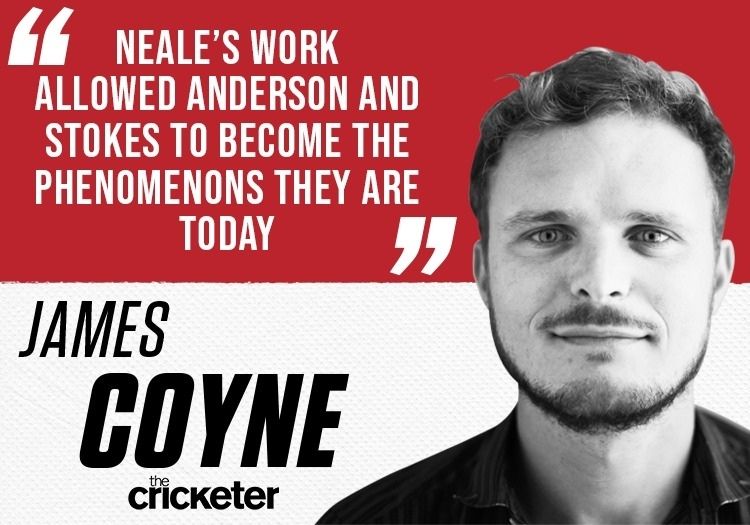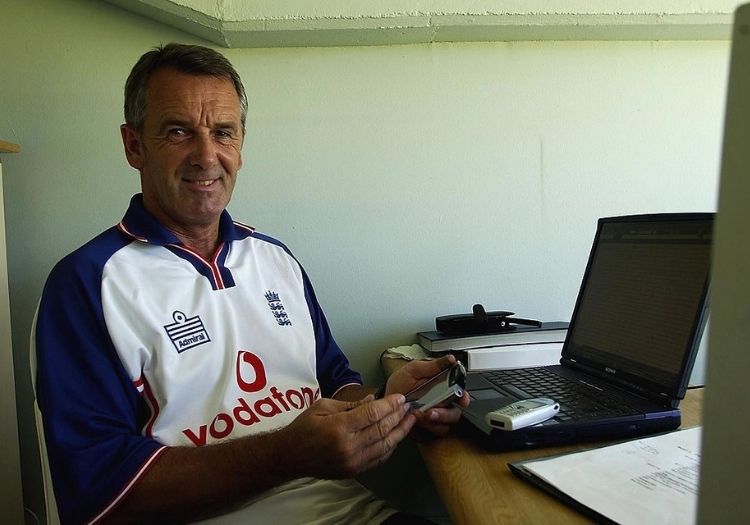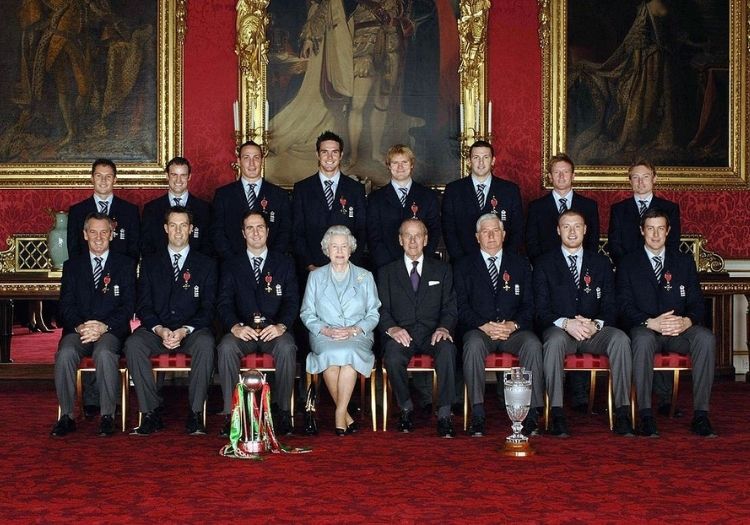JAMES COYNE: The last member of the backroom staff who predates central contracts has stepped away. And he will go down in history as the last man to combine a professional playing career in football and cricket

And so, farewell the 1990s.
The last remaining member of the England backroom staff who predates the introduction of central contracts, who was there when they began the climb out from the bottom of the Test rankings in 1999, has stepped down from his post.
For 21 years Phil Neale was the England team operations manager. If the England cricket team has, for much of that time – Pietersen imbroglios notwithstanding – resembled a well-oiled machine, then Neale, 66, is a sizeable part of the reason why. He is the man who made sure every bag has arrived in the right place or ensured every player and staff member has been catered for.
Or at least he did until India’s tour in 2018, more than 200 Tests and 300 ODIs into his tenure.
“I lost one bag,” he tells The Cricketer. “It was Adil Rashid’s, somewhere between Trent Bridge and the Ageas Bowl. The bags were taken out of the dressing room and put on a truck. We had lots of people helping us.
“The van got to Southampton before I did. But it was supervised being offloaded and we never did find his duffel bag with some bits in. Luckily it wasn’t bats or gloves or anything, but some kit he didn’t need particularly at the time, so we were able to replace it.
“But it’s frustrating that you travel all around the world with flights and all that, and we manage to lose a bag between two domestic county grounds.”
Neale’s perfect record up to that point will have been a huge point of pride to him. But he has been much more than just the bagman and logistics man.
And if this all seems mundane, just cast your mind back to the 1990s (if you were there) and remember just how many distractions and problems used to crop up for the players.
Lockdown impact on cricket, IPL in favour and the Rooney Rule problem
It is not uncommon now for England to have 16 backroom staff on hand for a Test match, tasked with looking after 12 players. Some of those staff are absolutely vital; at times it’s possibly been gilding the lily. Either way, it is a far cry from Neale’s own playing career, when he as Worcestershire captain would have shouldered many of the behind-the-scenes issues himself.
And when Neale first started out with England, there were not the cast of thousands attached to the team that there are now – for some of the first tours, there were just five: coach (Duncan Fletcher); manager (Neale); trainer (Nigel Stockill); physio (Dean Conway) and scorer (Malcolm Ashton).
So it was Neale who did much of the regular coaching alongside Fletcher in the first few years, as England attempted to climb themselves out of the mire. And, as Worcestershire captain for 10 seasons, and coach of Northamptonshire and Warwickshire for seven, this was someone who knew what he was doing. And that’s before we get onto his football career.
“I think Duncan Fletcher knew me as a coach, as I’d spent some time talking to him when I was coaching in South Africa with the Under-19s,” reflects Neale. “We were a good team.
“I learnt a lot from Duncan about coaching. In those initial four years, before we started bringing in official specialist and assistant coaches, there was basically me and Duncan doing the throwdowns and working with the players.
“And if I’m honest I probably enjoyed those years as much as any, because in my heart I’m a cricket person, who could turn his hand to the admin side to give himself some longevity in the sport.”
Throughout his 21 years, even as his coaching duties were gradually delegated to the specialist coaches who came into the set-up, Neale kept his role as the ‘nicker’ – whose job it was to stand there and deflect the ball towards the waiting slip fielders. Or, when the left-handed Fletcher – or later Andy Flower – was deflecting it to the other side, Neale would be the one flinging the ball down.
“It dovetailed quite well. Plus in the early stages, I still had an arm that was strong enough; nearly as strong as Duncan’s, which was incredibly strong.
“I can remember one session in India where we were a fair distance from each other, throwing it as hard as we could, and the slips were seriously far back. He was a master at it and I tried to learn from him.”

Phil Neale's role developed throughout his tenure
All this came at a cost, mind. Fletcher, Neale and Stockill all had to undergo shoulder injuries in the same year (2005 – memorable for other reasons too) due to the damage they had done to themselves hurling the ball down.
During Fletcher’s tenure sections of the press were nonplussed as to his golden touch. All the public saw was the sourpuss who grunted his way through reluctant press conferences – though they got more opportunities to ask him questions than the Indian media did during Fletcher’s near-hermitic stint as India head coach. It was all fine while England were winning, but after the 2006/07 Ashes, the knives came out sharpish.
Fletcher’s autobiography, which he approached seemingly more as an act of score-settling than a chance to bring his undoubted cricketing insights to a wider audience, did not really help his reputation.
Neale, for what it’s worth, comes out of the book very well: perhaps the funniest story – in retrospect – is him noticing Nasser Hussain, now back in the ranks with Michael Vaughan in charge, staring down Fletcher at dinner before his name was confirmed in the 2003/04 touring parties.
But it’s clear why the players loved Fletcher so dearly, for his was surely among the most fertile cricketing minds in the game. This, remember, at a time before cricket’s data revolution really got going – when using your own eyes, ears and brain, on the spot, were what made up a person’s cricketing judgement.
“Some of the stuff he taught you was biomechanically-based. And there wasn’t a lot of that around in those days,” says Neale.
“He used it to talk to players about how to get batsmen out – Herschelle Gibbs had a certain weakness with the way he brought the bat down, and if you bowled the top of off stump and nipped it back there was always going to be a gap there.
“I remember him talking to the players about playing Anil Kumble – if you tried to step back and cut, the angle the ball came in at would tuck you up and bring the risk of bowling you. The more you stepped away, the squarer the ball would go. If you stepped into the ball and let it run off the face, it would go just fine.
“I applied that to slip catching. Because the more you step away and try to get first slip and keeper involved, the squarer you end up hitting the ball. You’ve actually got to walk into the ball and almost let it run across your chest. Little things like that were what marked Duncan out.”

Neale played a key role behind the scenes - including during the historic 2005 Ashes series
Neale is not the type to overemphasise his own strengths, and aside from his own achievements in the game – captaining Worcestershire to two Sunday Leagues and two County Championships – he was a successful full-back for Lincoln City from 1975 to 1985. He will go down in history as the last man to combine a professional playing career in football and cricket.
As the years went on and his name ebbed into obscurity for a new generation of cricketers, he must have enjoyed slipping into team meetings the YouTube clip of him scoring for Lincoln City against Millwall, and being interviewed by Barry Davies, on Match of the Day. Yes, ‘Uncle Phil’ the bagman had been a high-class sportsman.
And there’s no doubt he picked up vital skills – on and off the football field – which he brought to his coaching and operational roles in cricket. He was especially influenced by his first manager at Lincoln, Graham Taylor, who would go on to manage Watford to great acclaim before the England job.
“Graham was a wonderful, exceptional individual and I learned a lot from him, especially about how to treat people. He was very firm but very fair.
“Football tends to makes rules for everybody, and the ones who obey the rules tend to feel let down a bit. Graham had the same set of rules for everyone, but the way he handled everyone was different depending on the person. He had two centre-halves who played together who didn’t really get on. But he managed it. He gave me some great advice down the years.”
It would be impossible to sustain two sports professionally now, due to the encroachment of the football season, the demands of all-year training in both sports, the changing attitudes to family life and the sheer money at stake. People struggle enough at amateur level.
Even so, Neale is a passionate advocate of playing other sports for as long as you possibly can.
“I sat in meetings when I was a coach and I was aghast that people were stopping young cricketers playing other sports because of the fear of injury. There’s a lot of other ways you can get injured. A lot of the best players in our team now have played other sports.” Jos Buttler, Jonny Bairstow, Chris Woakes and Eoin Morgan all spring to mind.
A reminder that, while Neale made his living for the last 21 years from making an organisation run smoothly, ultimately what it all comes down to is the ball, and the ever-stretching possibilities of what a human can make it do.
He can leave the stage knowing that his unglamorous work behind the scenes allowed Anderson and Stokes to become the phenomenons they are today.